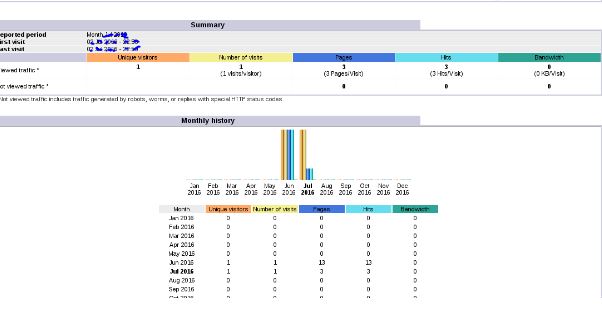

Understanding AWStats Configuration File Parameters :~ # /usr/lib/cgi-bin/ -config = -update
Awstats apache install#
On Debian or Ubuntu, I will install the Apache web server using the following commands. Install Apacheīefore I install AWStats, I need to have Apache installed.
Awstats apache license#
It can analyze log files from all major server tools like Apache log files (NCSA combined/XLF/ELF log format or common/CLF log format), IIS (W3C log format) and many other types of servers.ĪWStats is an Open Source tool released under a GPL license and is free for users in both commercial and non-commercial environments. It uses a partial information file to be able to process large log files, often and quickly. This log analyzer works as a CGI or from the command line and shows you all possible information your log contains, in a few graphical web pages. Understanding AWStats Configuration File ParametersĪWStats is a free powerful and featureful tool that generates advanced web, streaming, FTP, or mail server statistics, graphically.Setting up Auto-Update of AWStats Analytics Using Cron.Viewing and Testing AWStats Log Analysis Results.

You should see similar page on your web browser.Ĭongratulations! You have installed and configured AWStats in your CentOS 8 successfully. If you want to see your website stats use below link but don t forget to use your own Server IP and domain name in that link
Awstats apache update#
For example, we want to update website stats after every every 59 mins so we will configure cron job using below commandsĬreate cron job using below command crontab -eĪdd below lines in cron file */59 * * * * root /usr/share/awstats/-update You setup a cron job to keep updating your website statistics at specific time interval. If you face any error during execution of above command, use below command and try again, mkdir /var/log/httpd/-access_log Step 5: Setting up Cron Job Note: don’t forget to replace -config= with your domain name. Update your website statistics from current logs using below command Now save changes to file and restart apache systemctl restart httpd vi /etc/awstats/Īnd modify below lines in this file with your domain name Then make some changes in “ ” file, use below command to edit it. Now you need to make a configuration file for desired website so we can check its statistics.You can make separate file for each website.Ĭreate a copy of default AWStats configuration file with your domain name using below command cp /etc/awstats/ /etc/awstats/ systemctl restart httpd Step 4: Create AWStats Configuration File for Website In this article we will not edit this file. once you made the changes restart apache using below command. Now, install AWstats using below command dnf install awstats -yĪWStats generates an default Apache configuration file /etc/httpd/conf.d/nf This file allows access to all IP addresses but if you want to access Awstats from the particular network or IP addresses then modify the “Allow from” section in this file with your desired network IP. Step 2: Install Apache dnf install httpd -yĪfter Apache installation start and enable its services.
Awstats apache how to#
In this article, you will learn how to install AWSTATS on CentOS 8 Step 1: Install EPEL Repository dnf install epel-release -y Static reports can be created through a command line interface, and on-demand reporting is supported through a Web browser CGI program.

Data is visually presented within reports by tables and bar graphs. AWStats parses and analyzes server log files, producing HTML reports. AWStats is an open source Web analytics reporting tool, suitable for analyzing data from Internet services such as web, streaming media, mail, and FTP servers.


 0 kommentar(er)
0 kommentar(er)
